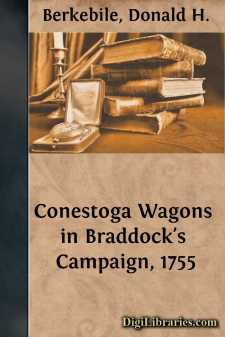Categories
- Antiques & Collectibles 13
- Architecture 36
- Art 48
- Bibles 22
- Biography & Autobiography 813
- Body, Mind & Spirit 142
- Business & Economics 28
- Children's Books 14
- Children's Fiction 11
- Computers 4
- Cooking 94
- Crafts & Hobbies 4
- Drama 346
- Education 46
- Family & Relationships 57
- Fiction 11829
- Games 19
- Gardening 17
- Health & Fitness 34
- History 1377
- House & Home 1
- Humor 147
- Juvenile Fiction 1873
- Juvenile Nonfiction 202
- Language Arts & Disciplines 88
- Law 16
- Literary Collections 686
- Literary Criticism 179
- Mathematics 13
- Medical 41
- Music 40
- Nature 179
- Non-Classifiable 1768
- Performing Arts 7
- Periodicals 1453
- Philosophy 64
- Photography 2
- Poetry 896
- Political Science 203
- Psychology 42
- Reference 154
- Religion 513
- Science 126
- Self-Help 84
- Social Science 81
- Sports & Recreation 34
- Study Aids 3
- Technology & Engineering 59
- Transportation 23
- Travel 463
- True Crime 29
Conestoga Wagons in Braddock's Campaign, 1755
Categories:
Description:
Excerpt
More than 200 years have passed since the Pennsylvania farm wagon, the ancestral form of the Conestoga wagon, first won attention through military service in the French and Indian War. These early wagons, while not generally so well known, were the forerunners of the more popular Conestoga freighter of the post-Revolutionary period and also of the swaying, jolting prairie schooners that more recently carried hopeful immigrants to the western territories.
The Author: Don H. Berkebile is on the exhibits staff of the Smithsonian Institution's United States National Museum.
In a speech to the Pennsylvania Assembly on December 19, 1754, Governor Morris suggested a law that would "settle and establish the wages" to be paid for the use of the wagons and horses which soon were to be pressed into military service for the expedition against Fort DuQuesne. His subsequent remarks on the subject were all too indicative of the difficulties which were later to arise. The Assembly however, neglected to pass such an act, and the Maryland and Virginia Assemblies were equally lax in making provision for General Braddock's transportation.
Sir John St. Clair had told Braddock, shortly after his arrival in the colonies in late February 1755, "of a great number of Dutch settlers, at the foot of a mountain called the Blue Ridge, who would undertake to carry by the hundred the provisions and stores...." St. Clair was confident he could have 200 wagons and 1,500 pack horses at Fort Cumberland by early May. On April 21 Braddock reached Frederick, in Maryland. There he found that only 25 wagons had come in and several of these were unserviceable. Furiously the General swore that the expedition was at an end. At this point, Benjamin Franklin, who was in Frederick to placate the wrath of Braddock and St. Clair against the Pennsylvanians, commented on the advantages the expedition might have gained had it landed in Philadelphia instead Alexandria, and pointed out that in eastern Pennsylvania every farmer had a wagon. Braddock then suggested that Franklin try to raise the needed 150 wagons and the 1,500 pack horses. Asking that the terms to be offered be first drawn up, Franklin agreed to the undertaking and was accordingly commissioned. On his return to Pennsylvania, Franklin published an advertisement at Lancaster on April 26, setting forth the terms offered (the full text of this advertisement is found in Franklin's autobiography).
Although eventually successful, Franklin was beset by many difficulties in collecting the wagons. Farmers argued that they could not spare teams from the work of their farms. Others were not satisfied with the terms offered. Furthermore, the Quaker-controlled Assembly had little interest in the war and did nothing to regulate the hire of wagons, in spite of the repeated pleas of the governor. Franklin published new advertisements more strongly worded than the first, threatening an impress of wagons and drivers if better cooperation could not be had. Finally the governor found it necessary to issue threatening warrants to the magistrates of four of the more reluctant counties. This action brought in the wagons but caused new difficulties to arise, for in order to prevent trouble the townships had contributed, in addition to the fifteen shillings per day offered in Franklin's terms, from five to fifteen pounds to each owner who would hire out his wagon.
[Figure 1.—Braddock's Route in the campaign of 1755....


